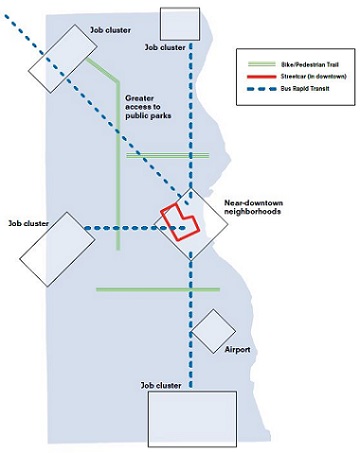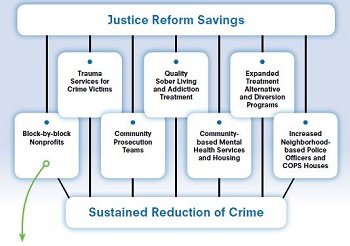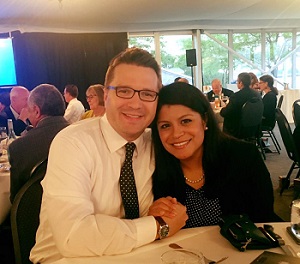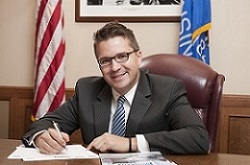
The Goyke Report - Publication Release
April 10,
2018
Contact Me
State Capitol
P.O. Box 8952
Madison, WI 53708
PH: (608) 266-0645
TF: (888) 534-0018
FAX: (608) 282-3618
E-Mail: Rep.Goyke@legis.wi.gov
On the Web:
goyke.assembly.wi.gov
Building the Bridge
"Without exception, the high-tech
cities in the US are also the most liberal. But it's not because
liberals are smarter that this is so. It's because liberal cities
tolerate odd ideas, and smart people have odd ideas." - Silicon Valley
entrepreneur Paul Graham
Tax Structure and
Policy
When you buy something or
get paid for doing your job, the tax revenue created from that commerce
gets sent to the State Government. The State spends your money on many
critical things. One is a formula called "Shared Revenue", which returns
some of the money back to local units of government like villages,
towns, cities and counties. Because Wisconsin's "Shared Revenue" policy
hasn't been updated since 2002, municipalities like Milwaukee send more
money to the state than it gets back.
By using a formula
that rewards local incentives like Tax Incremental Districts, segregated
barriers would be broken and revenue would be retained within the
city.
A More Competitive
Region
While local
governments need individual help, our region needs greater
collaboration. Since 1960, seven counties in southeast Wisconsin have
joined together to form the Southeastern Wisconsin Regional Planning
Commission (SEWRPC). SEWRPC gives technical assistance and planning
support to communities through the region. My idea is to add elected
positions by equal population districts within the seven counties of
SEWRPC and Authorize the entity to study, plan, and also implement
regional policies on issues such as economic development,
transportation, parks and recreation, housing, and environment and
sustainability.
A Center for New and
Small Businesses
Wisconsin's economic
development strategy is top-down and antiquated. The priority to
directly invest in existing large businesses siphons critical dollars
away from small or emerging business. A bottom-up economic development
strategy would leverage local partnerships, reduce default rates, and
would better reach communities in need of capital. My policy would
require the first 30% of WEDC's Investment target Community Development
Financial Institutions (CDFIs); CDFIs in turn leverage the State's
investment with private equity and philanthropic giving; CDFIs provide
counseling and mentorship to new and emerging businesses.
A
Modern Transportation Network
Milwaukee's fragmented
regional transit options prevent long-term economic and population
growth. Though we have been on a highway building spree (Marquette, Zoo,
Hale and Mitchell interchanges) we need walk-able, bike-able, ride-able
environments to support a more equitable and higher quality of life that
can attract and retain the talent our economy needs. The State has
proposed to spend $1,200,000,000 to reconstruct and expand I-94- but
what could we get if that money were spent on other non-highway
transportation infrastructure? We could get 46 miles ($690 million) of
Bus Rapid Transit that connects suburban job clusters with city
neighborhoods; 80 miles ($100 million) of bike/ pedestrian lanes
that allow greater access to promote public health, reduce crime and
attract residents; and 15 streetcar miles ($400 million) to connect the
downtown streetcar to near-downtown neighborhoods while also expanding
access for downtown commuters.
A Center of
Educational Excellence
Socio-economic status is a
major factor of educational achievement. Economically disadvantaged
students within MPS have a lower graduation rate compared to their
non-economically disadvantaged peers. Because of the link between school
and success, MPS and colleges in Milwaukee (and around the state) are
coming up with ways to help students get the education they need to be
successful.
Build
Safe Communities
Crime in Milwaukee can be
reduced. Neighborhoods that have the necessary combination of local
community leadership, nonprofits, or communities of faith and
investments to organize and coordinate with local law enforcement can
see substantial reeducations in crime. Targeting through place-based
policing and fostering police-community relationships have proven
effective in many chronically high-crime neighborhoods. Findings for
these proven policies can come from smart reforms elsewhere in the
criminal justice system.
There are many factors
behind each individual crime and there is no single policy that can
prevent all crime. A combination of successful and proven policies and
investments at the neighborhood level is needed to bring a sustained
reduction of crime.
My Milwaukee
I came to Milwaukee a
little over ten years ago. I didn't want to . I had an old, inaccurate
belief about the city. I was wrong. I'm grateful that I learned better.
Milwaukee has challenged me, but also opened me to so much. I'm a better
person, a better husband, and a better legislator for all of the lesson
I've learned here. I wouldn't live nay where else, but I also cannot
accept the status quo. We need massive, systemic change. Only through
offering options, receiving feedback, working toward compromise and
consensus will we realize the long-term changes we need.
Forward Together,
If you would like to have your name
removed from this email list,
please reply to this message
with “Unsubscribe” in the subject line




Evan
Friends and Neighbors,
Two years ago, I created a publication highlighting Milwaukee. My goal was to change the way the rest of the state views our wonderful city. A year ago, we began writing version 2.0.
Today, we publish The Bridge to Wisconsin's Future. This update includes many important pieces of the publication as well as a link to an electronic version. We will have hard copies available, but only for a very limited time. Please don't hesitate to call, write, or email if you are interested in obtaining a copy of The Bridge to Wisconsin's Future.
Due to rules regulating legislative offices during a campaign year, this will be my last electronic communication to you prior to November. Regardless, should any questions or concerns arise, please call my office at (608) 266-0645. I will also still be posting on my official Facebook and Twitter pages. I hope these help you stay informed. As always, please let me know if I can be of any assistance to you.

Evan Goyke
State Representative
18th Assembly District

Milwaukee:
The Bridge to Wisconsin's Future

Milwaukee is the tale of two cities. In one there is great momentum, excitement, and development. The other presents the difficult challenges of poverty and lack of economic mobility. The truth is, regardless of which Milwaukee you live in or which Milwaukee you envision, there must be sustained, collaborative work to push and pull every corner of Milwaukee forward. This is needed for the city, for the region, and the entire state of Wisconsin. The first part of this publication makes the case for Milwaukee's value to all Wisconsinites. The next tells the stories of a few families that call Milwaukee home. The publication concludes with areas for growth and proposes legislative solutions to the challenges presented.
The First Half of the Story

In 2016, Milwaukeeans voted on a new City Flag. The winning design, pictured above, was designed by Robert Lenz. The rising sun over Lake Michigan symbolizes a new day. The light blue bars in its reflection represent the city's three rivers and three founding towns. Gold represents our brewing history, and white symbolizes unity.
Milwaukee's Value to Wisconsin
Wisconsin's economy grows from Milwaukee, where more commerce takes place than anywhere else. Almost 40% of Wisconsin's GDP comes from the Milwaukee region.
Wisconsin's Transportation Hub
Milwaukee is not only a frequent destination for visitors, but is also home to Wisconsin's busiest highways, rail lines and port. General Mitchell Airport and the Port of Milwaukee both the busiest airport and port in the state of Wisconsin. Additionally, over 63% of all Wisconsin bus rides take place in Milwaukee.


Major Developments
Milwaukee's Street Car, "The Hop", has already attracted major investment and development. The initial route of the street car links four of Milwaukee's major development areas: Station Plaza, The Broadway Connection, Wisconsin Avenue and the Lakefront Gateway. One of the many new developments in Milwaukee is the new Buck's arena district - 40% of the construction jobs go to Milwaukee residents. Another new and exciting is the Northwestern Mutual Tower and Commons that will add to the city's elegant skyline.

The Second Half of the Story
Economic and Racial Disparities
Within the Milwaukee metro area, poverty is heavily concentrated within the city. Separate but unequal communities exist within the same region. Milwaukee's wealth and poverty are linked largely to geography and race. Milwaukee generates great wealth, but much of the wealth earned in Milwaukee leaves to neighboring counties. Each year Milwaukee's wealth subsidizes its suburbs in the billions. Hidden under the outflow of money is the truth that race follows the money. Currently, Milwaukee is the third most segregated city in America. Milwaukee also has one of the highest poverty rates in America.

Public Safety
Crime is a daily issue for Milwaukee families. The overall crime rate has decline after a spike in 2015. While the overall crime rate remains unacceptably high, progress can be seen in many ways and in many neighborhoods.

Resident Stories
Tirrell Brown is from the Metcalf Park/ Sherman Park neighborhood. Tirrell has been able to find a traditional job and subsidy program offered by the State to support his fiancée and their children.